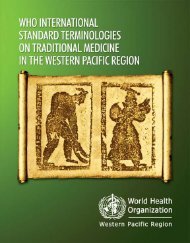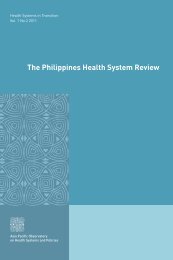Untitled - DOH
Untitled - DOH
Untitled - DOH
- No tags were found...
You also want an ePaper? Increase the reach of your titles
YUMPU automatically turns print PDFs into web optimized ePapers that Google loves.
National Framework Strategy on Climate Change Policy 2010-2022 Handbookchange. The changing climate conditions will have a myriad of impacts and underscore thevulnerabilities in all sectors of society and the economy. Adaptation will require resources and thecooperation of all sectors. Addressing climate change, therefore, moves beyond the environmentalchallenges and will have to be closely linked with economic targets and social sustainability.This Framework Strategy provides a basis for the national program on climate change. It identifiesKey Result Areas to be pursued in key climate-sensitive sectors in addressing the adverse effects ofclimate change both under adaptation and mitigation. The framework is based on the fundamentalprinciples of sustainable development and treats mitigation as a function of adaptation, cognizant ofthe vulnerability of key sectors that include energy.Increasing temperatures, changing rainfall patterns, sea level rise, and extreme weather events formthe backdrop upon which the Philippines endeavors to pursue its development goals. Such factorsaffect key sectors such as ecosystems, food, water, human health, infrastructure, energy, and humansociety. The ability of the country to address such impacts and vulnerabilities of these sectors affectthe facility by which sustainable development is pursued. Sustainable development, on the otherhand, greatly impinges on the capacity of the country to adapt to the impacts and addressvulnerabilities to climate change.In order to achieve the key result areas, it is important to ensure that cross-cutting strategies arelikewise given attention. As means of implementation, the framework puts forward multi-stakeholderpartnerships, financing, valuation, and policy planning and mainstreaming.The following diagram illustrates a more specific aspect of the Climate Change Framework, takinginto account how climate change impacts and vulnerabilities shall be addressed by adaptation,mitigation and cross-cutting strategies and supported by the means of implementation—which wouldeventually lead to achievement of the National Goal.CLIMATE CHANGE IMPACTS ANDVULNERABILITIESEcosystems Energy Food WaterCapacityDevelopmentKnowledgeManagementIEC andAdvocacyResearch andDevelopment/TechnologyTransferGenderM i t iCROSS-CUTTINGADAPTATIONEnhance Vulnerability andAdaptation AssessmentsIntegrated Ecosystems-BasedManagementClimate-Responsive AgricultureWater Governance &ManagementClimate Responsive HealthGOALMITIGATIONEnergy Efficiency &ConservationSustainable InfrastructureRenewable EnergyEnvironmentally SustainableTransportNational REDD + StrategyTo build the adaptive capacity ofcommunities and increase the resilience ofnatural ecosystems to climate change, andoptimize mitigation opportunities towardsMultiStakeholderPartnershipFinancingValuationPolicy, PlanningandMainstreamingMEANS OFIMPLEMENTATIONFigure 6: Operational Diagram7. SYNERGY OF ADAPTATION AND MITIGATIONThe increasing concentration of GHGs in the atmosphere has started to and will continue to influencechanges in the global climate system in the coming decades. The Fourth Assessment Report (AR4)of the IPCC and the international imperatives drawn in the Bali Conference in 2007 establish theurgency of adaptation especially for developing and vulnerable countries like the Philippines. ThisFramework recognizes the mutually beneficial relationship between climate change mitigation andadaptation, particularly in the context of Philippine development. Cognizant of the impacts of achanging climate on sectors that are also sources of GHG emissions, which include energy,3737
















